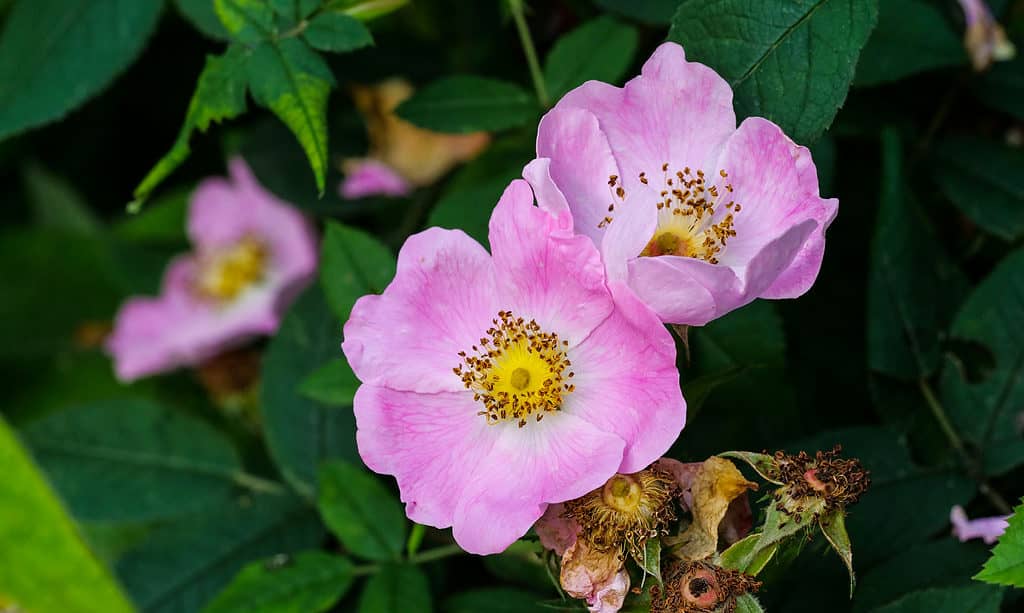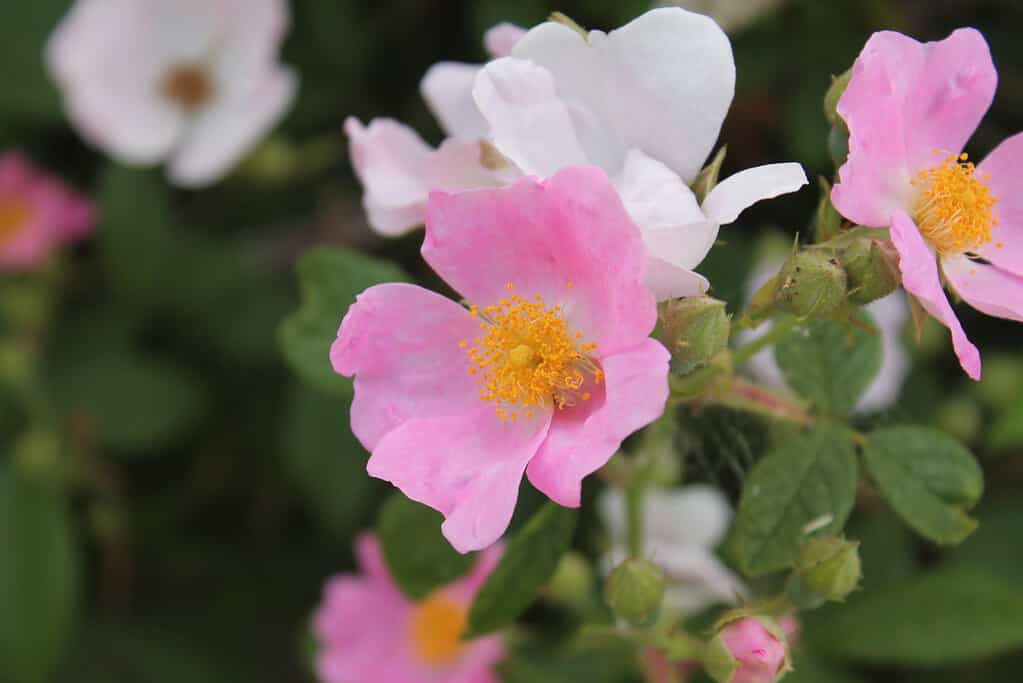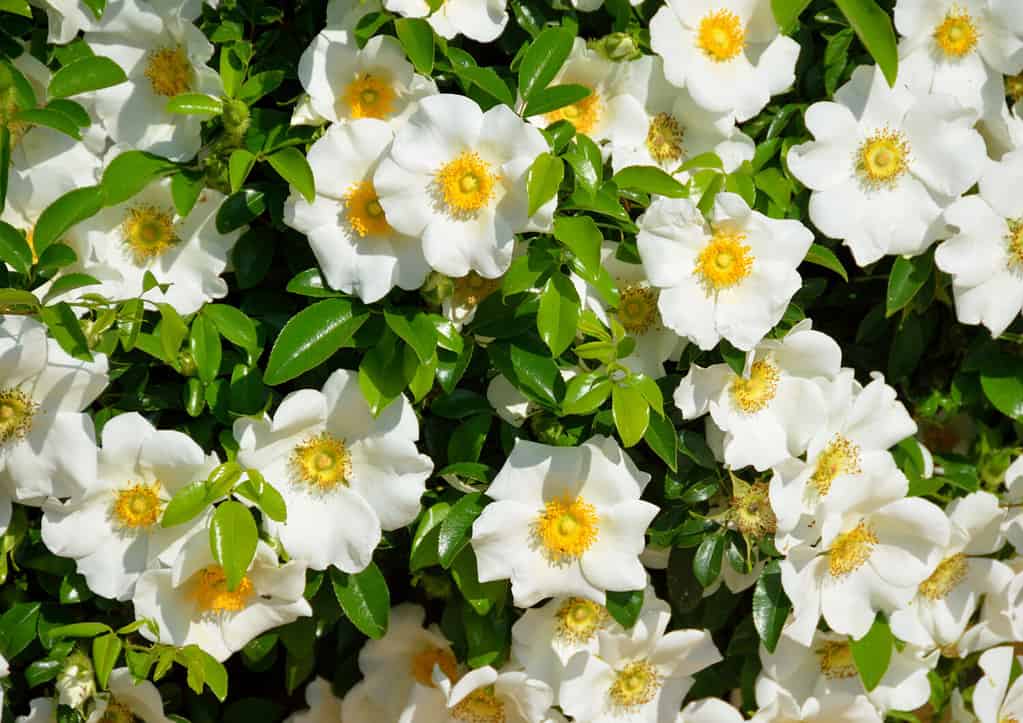When you picture roses, what do you see? Probably a lush, densely-petaled cut rose bouquet or a highly manicured rose garden. These gorgeous but delicate roses are the result of many, many years of cultivation and nurturing in gardens all over the world. But did you know that there are tough, wild, and unruly roses as well?
North America is home to several beautiful wild roses. Some are native and have evolved on the continent for millions of years while others have recently crossed the sea in the hands of humans. While wild roses appear across the entire country, the warm summers and cool winters of the South provide them with a perfect growing environment. In particular, there is a wide distribution of both native and non-native wild roses in Alabama.
In this article, we’ll take a look at some of the rose species that call Alabama home. We’ll find out what conditions they like to grow in, what they look like, and where they’re from if they aren’t native to the state.
Native Alabama Roses
First, let’s look at a couple of rose species that are native to the Southeast, both of which enjoy wide distributions across the state of Alabama. Having evolved alongside the state’s native wildlife, these beautiful roses have long-established roles in the ecosystems they call home.
Carolina Rose (Rosa carolina)
Despite its name, the Carolina rose (Rosa carolina) appears in more places than just the Carolinas. There are populations in almost every county in Alabama. It is a very hardy species and isn’t particular about its growing location. You’re just as likely to find it growing along high-traffic roadsides as you are along a secluded country hillside or woodline.
Like other roses, this species is a woody perennial. New spring growth is bright green and soft, hardening and developing a rough texture as the seasons progress. Mature canes are reddish-brown. At all life stages, the Carolina rose is armed with straight thorns, more accurately called prickles. These prickles usually form in pairs at each node.
When mature, Carolina rose bushes reach between 3 and 5 feet in overall height and spread to about the same width. They produce glossy, green compound leaves that appear along petioles in groups of 3–7 serrated leaflets. The leaves look just like those of garden rose cultivars and will likely have black spot mold in the wild, especially in moist areas or those with partial shade.
In the spring and early summer, this species is one of the loveliest in Alabama. Its fragrant flowers appear in great numbers all over the plant. They are usually about 2 inches in diameter, flaunting gentle shades of pink and bright centers of yellow stamens. Native birds, butterflies, moths, and bees love them and flock to the bushes during bloom. The flowers give way to several round hips that mature to a deep red as fall approaches, providing winter food for wildlife and humans alike.

The gently pink flowers of the Carolina rose are highly attractive to native birds and pollinating insects.
©Brookgardener/Shutterstock.com
Climbing Prairie Rose (Rosa setigera)
Another native Alabama rose, the climbing prairie rose (Rosa setigera) relishes the temperate climate of the South. While its statewide distribution is significantly smaller than that of the Carolina rose, it still appears fairly frequently in the western and northern portions of the state.
This species is unique among the wild roses in Alabama. Unlike its shrubbier relatives, it behaves quite like a vine, using its curved prickles to climb nearby obstacles. This trait makes it popular among gardeners who frequently train it to grow along fence lines and trellises.
At the upper end, these plants can climb as high as 12 feet! You may see their canes arching over rocks, snags, tree branches, and other shrubs. Their sprawling nature helps them spread through their environment, as they can set roots anywhere one of their canes touches the soil. While other roses can do the same thing, this species is especially good at it. You’re very likely to encounter this plant along roadsides, as homeowners and road departments frequently use it to control erosion on difficult slopes. It also appears on its own in prairies and along the edges of pastures and wood lines.
Like its relatives, it is a popular host for pollinators and provides valuable food and cover to local animals in every season. In the spring and summer, light pink flowers appear in clusters along the trailing canes. As they age, they gradually lose their pigment and take on a blush-white coloration. While the climbing prairie rose isn’t a repeat bloomer, it continues to put on a show long after its flowers fade. As autumn arrives, its foliage transforms from bright, shiny green to varying shades of deep red and purple.

During spring, the climbing prairie rose produces clusters of small, pink flowers
Non-native Roses in Alabama
While there are large distributions of native roses in Alabama, you’re also quite likely to encounter some non-native ones. From rootstock for grafting to standalone ornamentals, gardeners have imported foreign roses for several reasons. Over the years, these species managed to escape captivity and establish thickets all across the state.
Let’s have a look at the most common ones below.
Multiflora Rose (Rosa multiflora)
Though the multiflora rose (Rosa multiflora) is native to China, Japan, and Korea, it finds a home today in the Deep South. At one time, the U.S. Soil Conservation Service encouraged farmers and landowners throughout the South to plant the species to mitigate soil erosion and provide food and cover for local wildlife. While the multiflora rose certainly accomplished those tasks, it also spread aggressively throughout the region, taking to its new environment like a duck to water. Today, it is one of the most widespread roses in Alabama, leading legislators to declare it a Category 1 invasive species.
This wild rose has a remarkable ability to propagate itself and survive adverse conditions. Where most roses would struggle with wet, heavy soil, high humidity, and lack of airflow, the multiflora rose simply shrugs. It even sets down roots in areas prone to flooding. Because it is so tough, rosarians frequently use multiflora rose as rootstock to give their garden cultivars a leg up on life.
When mature, these woody shrubs can grow 12–15 feet in height and spread equally as wide. The canes produce a pair of recurved prickles at each node and become hard and woody with age. The soft spring growth arches as it grows lengthwise and, like other wild roses, takes root where it contacts the soil. A few young plants can produce a dense, impenetrable thicket in just two or three years!
In the spring and summer, this species produces an incredible density of tiny, white, 5-petaled flowers. Because they are so popular among pollinators, plants usually produce an equal abundance of rosehips which ripen to fiery reddish-orange in the fall and persist through the winter.

©Przemyslaw Muszynski/Shutterstock.com
Cherokee Rose (Rosa laevigata)
The Cherokee rose hails from southern Asia. Despite its Native American common name, its native range covers large parts of Laos, Taiwan, and central and southern China. The flower has existed on the continent for hundreds of years, having established itself long before French botanist André Michaux cataloged his first specimen in 1790. Its common name comes from the flower’s association with the displacement of the Cherokee people by European colonizers during the colonial era of the United States.
This species spreads very quickly owing to its leggy, sprawling nature and strong suckering ability. In addition to its great tolerance for shade, poor soil, and humidity, it is also an incredibly strong climber. Like the climbing prairie rose, it uses its sharply hooked prickles to grab ahold of obstacles in its path and ascend to great heights. It can weave through tree branches, drape itself over walls, and traverse rocks and hillsides with ease. Where the climbing prairie rose tops out at about 12 feet tall, however, the Cherokee rose can stretch as high as 60 feet!
In the spring, usually in late March and April, the Cherokee rose produces single flowers from the ends of each of its lateral branches. The thick, velvety flowers have five petals and are quite large for wild roses, growing up to 3 inches in diameter. Though they sometimes lose their leaves in the fall, Cherokee roses thoroughly enjoy the South’s warm climate. In USDA zones 7–9, it is considered a semi-evergreen and is likely to retain its foliage throughout most or all of the winter.

The boldly colored Cherokee rose is quite tolerant of shade, humidity, and the foliar diseases, like blackspot and powdery mildew, that the two tend to cause.
©Paul Brennan/Shutterstock.com
Thank you for reading! Have some feedback for us? Contact the AZ Animals editorial team.








